Siosepol Bridge | 33 Archs on Zayandeh Rud
Isfahan, often referred to as "half of the world" in the Persian proverb "Isfahan Nesf-e Jahan," stands as a city steeped in cultural and historical significance.
Enlarged during the reign of Shah Abbas I with the ambition to transform it into the capital of trade, art, and sports in Iran, Isfahan boasts a wealth of architectural wonders and natural beauty. Among these treasures is Si-o-se-pol, a bridge that has become an emblem of the city's grandeur.
Siosepol Bridge, known colloquially as the "Bridge of 33 Arches," serves as a crucial link over the Zayandehrud River, seamlessly connecting the northern and southern regions of Isfahan. Join us on this journey through time and architecture, discovering the allure of one of Isfahan's most iconic landmarks.
A Glance at Si-o-se-pol Bridge Facts
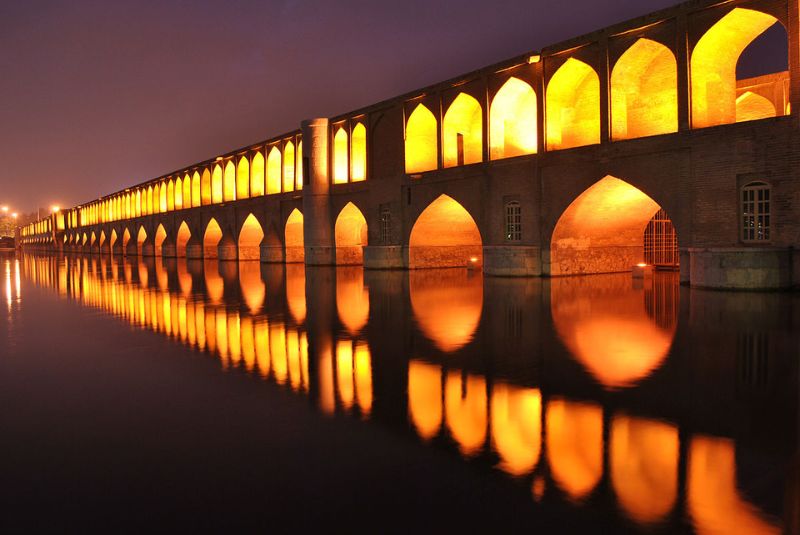
- Built during the Safavid Dynasty between 1599 and 1602, and is 421 years old.
- "Si-o-se-pol" translates to "Bridge of 33 Arches" in Persian, representing the number of arches that characterize the structure.
- Si-o-se-pol bridge length is 76 meters (976.9 feet).
- Si-o-se-pol bridge height is 14.75 meters (48.4 feet).
Among the longest and widest bridges, Si-o-se-pol stands as a masterpiece of Persian architecture in Iran.
- Originally constructed to function as both a dam and a bridge, it played a crucial role in regulating the flow of the Zayandeh River while providing a passage for pedestrians and horses.
- Si-o-se pol bridge has left an indelible mark on art and culture, including paintings, poetry, and literature, attesting to its cultural resonance.
Historical Background; Why was the Si-o-se-pol Bridge Built?

The Allahverdi Khan Bridge (پل اللهوردی خان), Si-o-se-pol (سیوسهپل), colloquially known as the "Bridge of 33 Arches," was commissioned and built between 1599 and 1602 under the reign of Shah Abbas during the Safavid Dynasty.
The relocation of the Safavid Empire's capital from Qazvin to Isfahan in 1598 played a pivotal role in the decision to construct Si-o-se pol bridge. Positioned in close proximity to the Zayandehrud River, the bridge not only served as a practical means of crossing the river but also became an integral part of Shah Abbas's grand vision for Isfahan. The river, a vital source of life and nourishment for the city, contributed to the strategic importance of Si-o-se-pol.
Shah Abbas I's foresight in moving the capital to Isfahan and investing in the construction of Si-o-se-pol underscored his commitment to transforming the city into a cultural and economic center.
Over the course of its 420-year history, Si-o-se-pol witnessed changes in the river's dynamics, with periods of dryness altering the original purpose of the bridge. Beyond its utilitarian function, Si-o-se pol bridge became a hub for diverse activities, including evening strolls, public gatherings, events, and as an observation point for regattas and water sports. This adaptive use showcases the enduring cultural significance of Si-o-se-pol throughout the centuries.
| Related: Isfahan's Khaju Bridge
Why Siosepol Bridge is Called Allahverdi Khan Bridge?
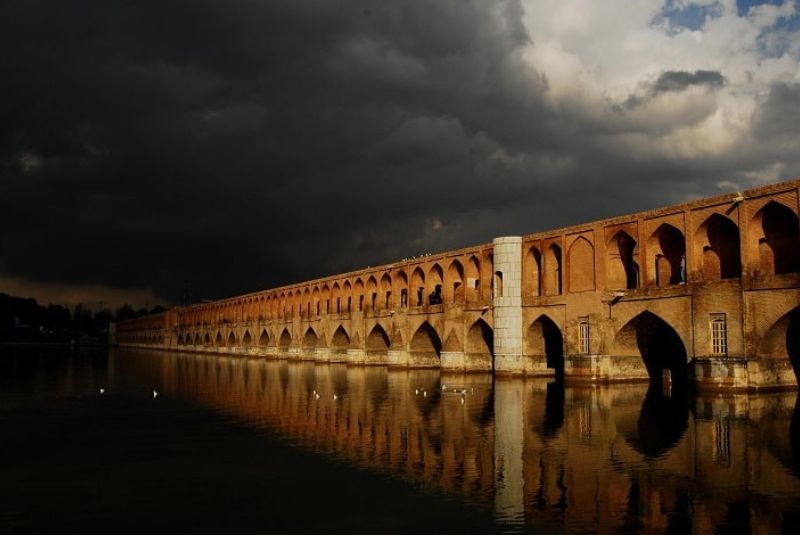
Si-o-se-pol Bridge, often referred to as Allah Verdi Khan Bridge, derives its alternate name from the esteemed figure of Allah Verdi Khan, the valiant commander of Shah Abbas the Great’s army during the Safavid Dynasty. Allahverdi Khan Undiladze, as the overseer of the construction, played a crucial role in executing Shah Abbas's vision for the bridge.
Born in Georgia, Allah Verdi Khan's journey to prominence started when he was sold as a slave to Iranian traders. Under the reign of Shah Tahmasb, the second Safavid king, Allah Verdi Khan transformed into a formidable young man and entered the Safavid army, swiftly ascending the ranks.
His notable military prowess and dedication earned him recognition, eventually establishing him as one of the most esteemed commanders during Shah Abbas the Great's reign. Allah Verdi Khan's valor was particularly highlighted in the war against the Portuguese for the island of Hormuz. His bravery played a crucial role in reclaiming the island, marking a significant victory for the Safavid Empire. The spoils of this conquest contributed to the Iranian army, solidifying Allah Verdi Khan's legacy.
Notably, Allah Verdi Khan undertook the role of the founder of Si-o-se-pol Bridge, personally covering all the construction costs. Beyond his military achievements, this act further illustrates his commitment to the cultural and infrastructural development of Isfahan. Thus, the name Allah Verdi Khan Bridge stands as a tribute to a distinguished military leader and the visionary behind the construction of this iconic bridge.
| Discover: Top 10 Isfahan Mosques You Should visit!
Design And Construction Of The Siosepol
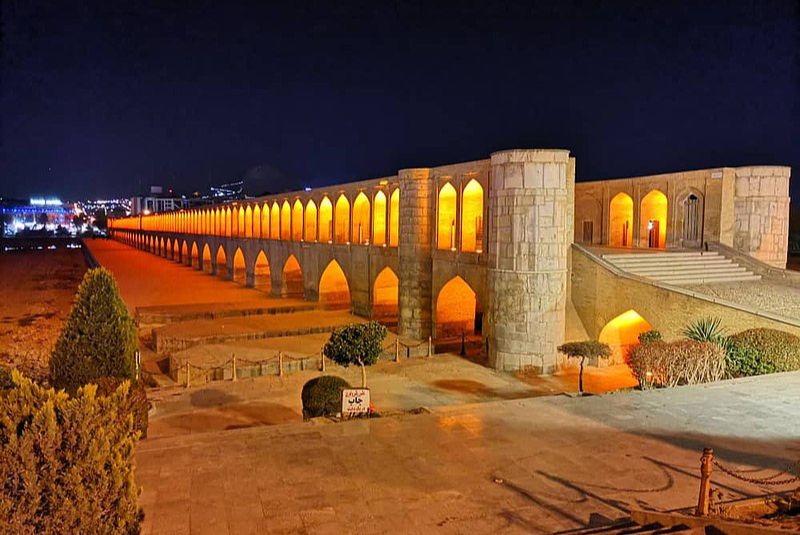
Si-o-se-pol boasts impressive dimensions, with a length of approximately 295 meters (970 feet), making it one of the longest bridges in Isfahan and with the total width of 14 meters (48 feet). Its substantial size showcases the engineering prowess of the Safavid era.
The bridge exhibits a carefully planned design, characterized by a series of 33 arches that seamlessly span the Zayandehrud River. The symmetrical layout and meticulous arrangement of these arches contribute to both the structural integrity and aesthetic harmony of Siosepol Bridge, a prime example of Safavid architectural brilliance. Influenced by the Safavid Dynasty's emphasis on grandeur and aesthetic finesse, the bridge embodies the era's architectural principles.
Each of the 33 arches presents unique characteristics, adding a distinctive charm to the bridge. The design incorporates a thoughtful interplay of light and shadow, creating a visually captivating effect. The arches, evenly distributed along the length of the bridge, contribute to its iconic silhouette against the Isfahan skyline.

The construction of Si-o-se pol bridge utilized a combination of durable materials, reflecting the architectural sophistication of the Safavid era. Stone, particularly brick and mortar, formed the primary building components, ensuring the bridge's resilience against the test of time and environmental elements.
The bridge served as both a bridge and a dam, controlling the flow of the Zayandeh River. 33 arches on the upper level of the bridge, create a pedestrian walkway with beautiful river views.
| Read more: Ghoortan Citadel | Desert Fortress of Legends in Isfahan
Siosepol's Cultural Significance
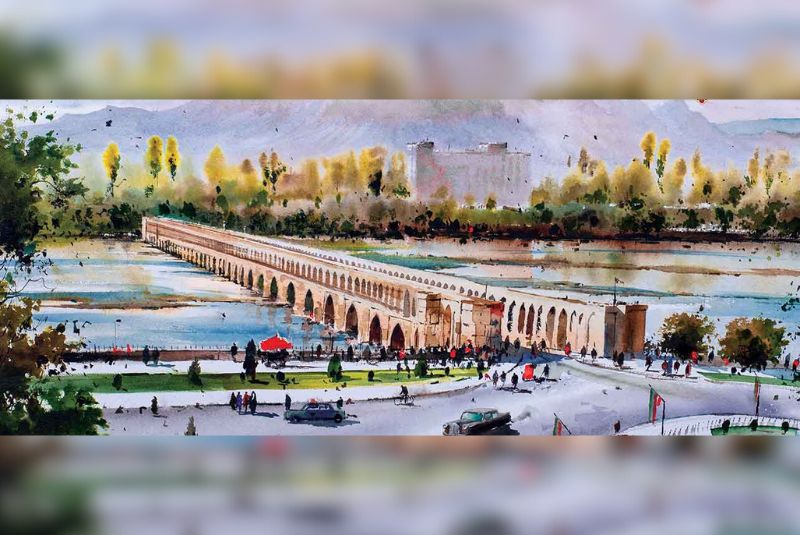
Siosepol Bridge played a pivotal role in facilitating trade and transportation within Isfahan during the Safavid era. Positioned strategically over the Zayandehrud River, the bridge connected the northern and southern sectors of the city, fostering the movement of goods and people. Its architectural magnificence not only enhanced practical infrastructure but also contributed to the economic vitality of Isfahan.
Beyond its utilitarian functions, Si-o-se-pol evolved into a cultural nexus, witnessing social gatherings and events. The convergence of trade, practicality, and cultural prominence underscores the bridge's dual significance, solidifying its place as a cultural icon in the historical narrative of Isfahan.
| Suggestion: Persian Gardens; Pieces of Paradise in Iran
Ceremonies Held at Siosepol Bridge

During the reign of Shah Abbas, Si-o-se-pol served as a vibrant venue for various ceremonies. Notably, Nowruz (Persian New Year) celebrations unfolded on this bridge, spanning from three to seven days. As Shah Abbas passed, the revelry included the tradition of showering the path with an abundance of flowers, creating a vivid spectacle in his wake.
The Water Festival at Siosepol Bridge was another grand event during the Safavid Dynasty. Participants engaged in lively water festivities, splashing and pouring water and rosewater on each other, adding a refreshing and joyful dimension to the cultural festivities hosted on the bridge.
Additionally, the bridge played host to the annual Epiphany festival celebrated by Armenians every January. This rich tapestry of ceremonies underscores the historical and cultural significance of Si-o-se-pol as a communal space for diverse celebrations and traditions.
Visiting Siosepol Bridge in Isfahan

Si-o-se-pol offers a range of activities for visitors. On the lower deck, a teahouse beckons, inviting you to relish a cup of authentic Persian tea while soaking in the scenic beauty. Capture the charm of the surroundings, especially during the evenings, by bringing your camera. Engage in cultural exchanges with the locals, enjoy the melodies of songs and poetry recitations, and take a moment to quietly observe the flowing water, the graceful flight of birds, and the lively conversations of people. The siosepol bridge in Isfahan welcomes visitors without any admission fee, allowing everyone to indulge in its beauty freely.
| If you got to travel to Isfahan to visit Siosepol, don't miss Aali Qapu Palace!
Siosepol Bridge Location
Located at the confluence of Chahar Bagh-e Abbasi and Chahar Bagh-e Bala streets, Si-o-se-pol Bridge seamlessly extends the urban landscape. Positioned in the city center, this iconic bridge offers immediate proximity to Isfahan's main attractions, making it an easily accessible focal point for visitors.
A leisurely stroll to the north along Chahar Bagh-e Abbasi street, lasting around 20 minutes, leads to the historic Naqsh-e Jahan Square, alongside the enchanting Hasht Behesht Palace and the opulent Chehel Sotoun Palace.
On the southeastern flank of the bridge, one discovers cultural marvels like the Vank Cathedral and the Isfahan Music Museum. The panoramic view from Siosepol Bridge encompasses other notable bridges, including Joui and Khaju bridges, harmoniously spanning the Zayandehrud River.
Ensuring convenience, the Si-o-se-pol metro station is conveniently located near the north end of the bridge. The vicinity is well-served by multiple bus stops, shopping centers, cafes, and hotels, providing a centralized hub for exploring the rich tapestry of Isfahan's attractions.
| Discover: Best Dishes in Isfahan You Must Try!
Best Time to Visit Isfahan Siosepol

For an optimal experience, the evening is universally acknowledged as the prime period to visit Si-o-se pol bridge. As the sun descends, casting a tranquil ambiance along the riverfront of Zayandehrud, visitors can unwind after a day brimming with tours and sightseeing.
With the onset of darkness, the bridges come alive with the glow of hundreds of lamps, creating a mesmerizing reflection in the river waters. This magical transformation enhances the allure of Si-o-se-pol, offering a captivating visual spectacle that is particularly enchanting during the evening hours.
Venture out to observe the lifestyle of Isfahan's citizens, immerse yourself in the melodies of street musicians, and relish a leisurely stroll along the riverbank. The evening ambiance at Si-o-se-pol presents a unique opportunity to engage with the city's essence, making it an ideal time for a serene and culturally enriching experience.
It's important to note that the availability of Zayanderud water may vary due to climate changes throughout the year. Consequently, the magnificent reflection of the bridge on the water and the soothing sound of flowing water might not be present on every day.
For an enhanced experience, spring and fall emerge as more favorable times to plan a visit. During these seasons, the climatic conditions are more conducive to witness the picturesque reflections and appreciate the tranquil ambiance created by the flowing waters. Selecting spring or fall for your visit to Si-o-se-pol ensures a heightened sensory experience, allowing you to fully immerse yourself in the captivating beauty of Siosepol Bridge.
| Also read: Shah Mosque, Isfahan | A Complete Visitor Guide
Attractions and Landmarks Near Si-o-se-pol Bridge

Si-o-se-pol Bridge, situated in the heart of Isfahan, serves as a gateway to a plethora of attractions and landmarks that enrich the cultural tapestry of the city. Explore these nearby points of interest to complement your visit:
- Naqsh-e Jahan Square: A short stroll to the north along Chahar Bagh-e Abbasi street leads to Naqsh-e Jahan Square, a UNESCO World Heritage site and one of the largest city squares globally. It is surrounded by architectural marvels such as the Shah Mosque, Ali Qapu Palace, and the Sheikh Lotfollah Mosque.
- Hasht Behesht Palace: Adjacent to Naqsh-e Jahan Square, Hasht Behesht Palace offers a serene retreat with its meticulously designed gardens and exquisite architecture. The palace, dating back to the Safavid era, provides insight into the opulence of Persian royal residences.
- Chehel Sotoun Palace: Continuing your exploration to the north, Chehel Sotoun Palace awaits. The "Forty Columns Palace" is renowned for its enchanting reflection in the adjacent pool and the beautiful frescoes adorning its walls.
- Vank Cathedral: To the southeast of Si-o-se-pol Bridge lies Vank Cathedral, a splendid example of Armenian architecture. Admire its vibrant frescoes and explore the Armenian history showcased within the cathedral's walls.
- Isfahan Music Museum: Also in the southeast, the Isfahan Music Museum offers a captivating journey through Iran's musical heritage, featuring a diverse collection of traditional instruments and exhibits.
- Joui and Khaju Bridges: Enjoy the scenic beauty of other bridges over the Zayandehrud River, including Joui and Khaju Bridges, offering unique perspectives of the river and its surroundings.
| Visit Sheikh Lotfollah Mosque in Isfahan!
Accommodation near Si-o-Se-Pol Bridge
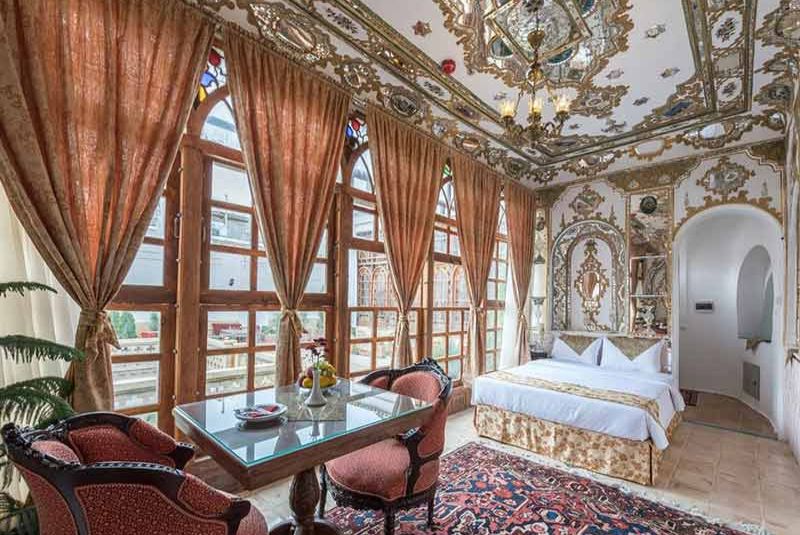
Experience a mesmerizing view of Si-o-Se Pol Bridge right from your hotel room by considering various accommodation options. Among these, the closest is the distinguished 5-star Parsian Kowsar Hotel, offering exclusive rooms and suites alongside impeccable service. Another luxury choice is the historic Abbasi Hotel, Iran's oldest establishment, along with Parsian Ali Qapu Hotel.
For a more budget-friendly stay, several hotels within walking distance provide excellent alternatives. Consider the Pars Hotel or Tourist Hotel.
| Related: Best Hotels in Isfahan to Stay
Dining Options near Si-o-Se-Pol Bridge

Exploring the culinary delights around Si-o-Se-Pol Bridge is a rewarding experience, given its status as a prime tourist destination. A variety of noteworthy restaurants await your indulgence:
- Arakhan Restaurant: Delight in traditional kebabs in the charmingly decorated ambiance of Arakhan Restaurant, offering a taste of authentic Iranian cuisine.
- Shahrzad Restaurant: Explore one of Isfahan's renowned dining establishments, Shahrzad Restaurant, celebrated for its culinary excellence and cultural significance.
- DiroozEmrooz Cafe: For a more contemporary setting, indulge in snacks and coffee at DiroozEmrooz Cafe, providing a modern atmosphere for a casual dining experience.
- Bazaar Cafes and Tea Houses: Immerse yourself in the depth of Iranian culture by visiting the bazaar, where small cafes and tea houses offer a unique blend of traditional flavors and local charm.
| Related: Best Restaurants in Isfahan
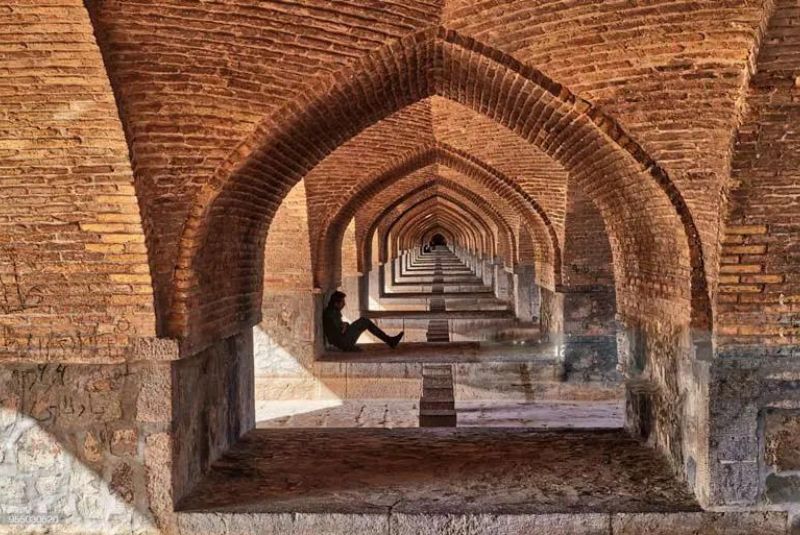
Bottom Line
As you traverse the 33 arches of Si-o-se pol bridge, you witness a masterpiece of Safavid engineering and immerse yourself in the vibrant ambiance of Isfahan. From the panoramic views of Zayandehrud River to nearby cultural wonders, every step echoes with the footsteps of history.
Isfahan, with its warm hospitality and architectural marvels, invites you to experience its charm. Plan your journey, discover the allure, and let Si-o-Se-Pol Bridge be your gateway to the enchanting city of Isfahan. Your adventure awaits!
Share your story!
Comment below and let us know about your Experience.
Your story inspires others!


Comment
Leave a Comment